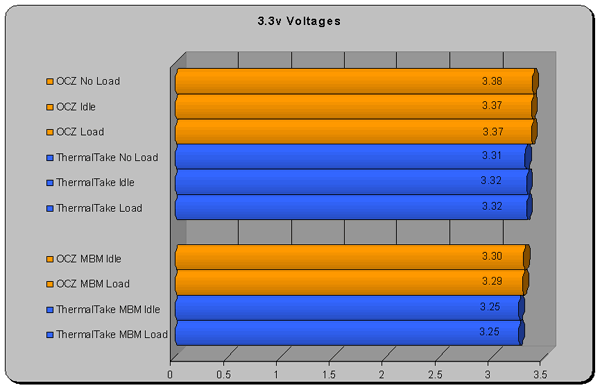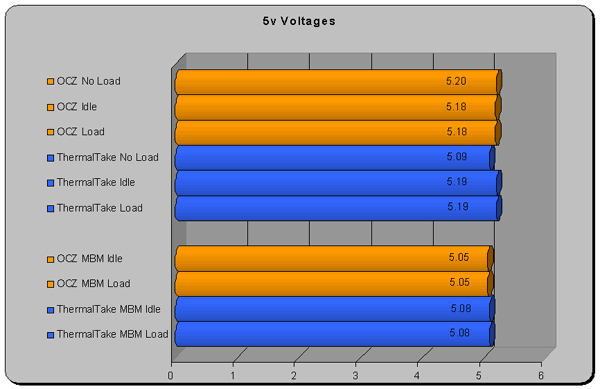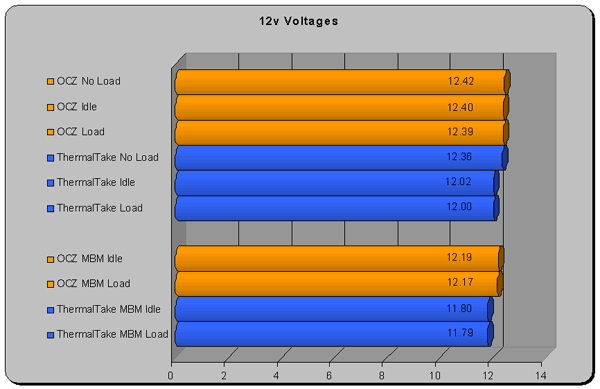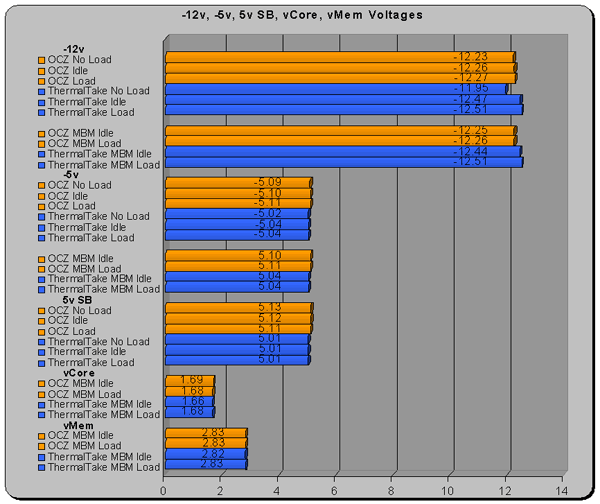OCZ PowerStream 520W PSU
Testing
I tested the OCZ PowerStream power supply on the following setup using a multimeter,
motherboard monitor, and my sound pressure level meter.
- Abit NF7-S rev. 2
- AMD 2500+ mobile @ 2.275ghz
- 512mb Kingmax PC4000
- Matrox G450 Video
- 2x 160GB Seagate SATA hard drives
- 120GB Western Digital hard drive
- Sony 8x DVD/RW
- 2x 120mm case fans
All voltages were taken from the ATX power connector and compared with voltages
reported from Motherboard Monitor 5. They were taken without load (no computer
connected), after the computer had idled for 30min, and again after 30min at
full load. Load was achieved by defragmenting the Western Digital hard drive
while rendering a 5min film in Vegas 4.0, and running folding@home in the background
to use any spare CPU cycles. Vegas loads the system by reading large video files
from a drive rendering a video effect frame by frame and then writing the frame
to the hard drive again, this particular sequence taxed my system at 97-99%
at all times, any remaining CPU time was used by F@H and the defrag utility.
**Note about changes: I recently updated my bios and was able to push my motherboard
to 227fsb, this has upped my cpu speed to 2275mhz up from 2200mhz. While 75mhz
should not make a huge difference it does mean that the ThermalTake Silent PurePower
Fanless power supply was tested under slightly different circumstances and thus
all test data should be understood with this in mind.**

The PowerStream was a flawless performer with the 3.3v power rail. It exhibited
virtually no difference in voltage when idle or under load.

Again, the PowerStream proved that it can handle more. The 5v rail shows that
it can provide rock steady power idling or under load. The PowerStream also
showed less deviance from no load to idle/load than did the ThermalTake. Under
normal circumstances this would be where I criticize OCZ for not meeting its
1% tolerance for rail voltages, except that if the voltage is too high, as it
is here, all you have to do is go around to the back and turn it down.

Readings from the 12v lines paint a similar picture: one stable and powerful
power supply. Notice that the ThermalTake dropped from 12.36v to 12.00v when
put under load. While the OCZ showed a far, far less dramatic change of only
0.03v. We do need to keep in mind that my computer at full load pulls around
250w which is a walk in the park to the OCZ.

A quick glance at this graph will show you what you expect, more of the OCZ
PowerStream doing what it does best, providing more than enough power. Most
of the voltages in this graph are of low importance so any variation here is
far more tolerated. The only exception to that is the vCore and vMem. Yet even
here we find the OCZ keeping the motherboard supplied with solid voltage, and
any variation can be attributed to the motherboard or changes in operational
use.
The only thing left to test is the PowerStream’s noise levels. When I
saw the box and it said that the power supply stays below 30dB I was skeptical.
Most fans generate noise, if not motor noise then noise from the air movement.
The OCZ PowerStream is no exception to this rule; in testing I measured it at
40.8dB. Now in all fairness I do not have an anechoic chamber nor do I have
the most expensive SPL meter, but I can tell you that when I placed the power
supply in a very, very quiet room it was audible. When I say quiet I mean that
the noise floor is below the threshold of my testing equipment of 35dB. This
does not mean that OCZ is outright lying about how quiet the power supply is,
the PowerStream is very quiet, and in a normal room with other components like
hard drives and CPU fans running it is extremely unlikely that you will ever
hear the PowerStream’s fans running.

Comments are closed.